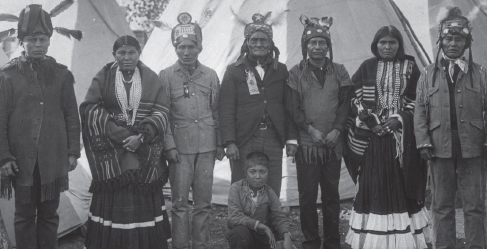
Image Credit: National Archives
Band of Apache prisoners at a rest stop beside Southern Pacific Railway, near Nueces River, Texas on September 10, 1886. Among those on their way to exile in Florida are Natchez (center front) and, to the right, Geronimo and his son in matching shirts. At Fort Marion, many Apaches sickened and died. A year later, the government sent the survivors to Alabama.
Atrain carried the Apaches to Fort Marion, Florida. The Apaches lived for a while on the beach. They waited while a well was drilled in the fort. A healthy diet and cleanliness were hard to come by. Rations were cut twice in 1886. Two bath tubs served 469 people. The Apaches died from disease and fevers. Among them was Geronimo’s four year old daughter. Many Apaches died from tuberculosis.
These once active people now lived a life of idleness. The women prepared meals and made clothing. The men had no chance to work. Their only task was to keep the place clean. The Army forced some of the youths to attend Carlisle Indian School.
Crook and others protested the treatment of the Apaches. In April 1887, President Cleveland acted. He sent the Apaches to Mount Vernon Barracks, Alabama. There, Geronimo rejoined his family. He said, “We were not healthy in this place. The climate disagreed with us.”1 A doctor said Apache lungs could not withstand the dampness. Many caught tuberculosis. Others suffered from malaria. By 1889, one fourth of the Apaches had died. Still the Army kept the Apaches at Mount Vernon for six years.

Image Credit: Library of Congress
In 1904, Geronimo attended the World’s Fair in St. Louis. He sold autographed photos and handmade bows.
In 1893, the Army moved the Apaches to Fort Sill. Here, in the Indian Territory (now Oklahoma), they grew corn, melons, and squash. Grasslands fed their cattle. Yet it was not their native homeland. The Apaches continued to die of despair and disease.
Geronimo was still well known. People wanted to see the famous old warrior. Some paid money to do so. On a trip to Omaha, crowds greeted him at each trainstop. They saw an old Apache dressed in white man’s clothes. They found it hard to think of him as a feared warrior. He sold them the buttons off his jacket for twenty five cents each. Then he sewed on new buttons to sell at the next stop.

Image Credit: Library of Congress
Geronimo died in 1909. Neither the Apaches nor the world has forgotten their famous leader.
In 1904, Geronimo attended the World’s Fair in St. Louis. He sold autographed photos and handmade bows. He met with General Miles. Geronimo said that the acorns, piñon nuts, wild turkeys, and giant cactus all missed him in Arizona. Miles said that might be true. But the people there could sleep at night knowing he was elsewhere.
In 1905, Geronimo rode in the inaugural parade of Theodore Roosevelt. He told the President, “Great Father. White men are in the country that was my home. I pray you to tell them to go away. Let my people go there and be happy.?”2 Roosevelt said the Apaches would remain at Fort Sill.
In 1906, Geronimo told the story of his long life. A young teacher wrote it down. Geronimo wanted the public to know his side of events. Then, he hoped, they would support his wish to go home.
Geronimo lived in despair and depression. In February 1909, he rode alone to a nearby town. The weather was cold, the ground icy. Against the rules, he bought a bottle of whiskey. Geronimo drank heavily. He fell from his horse into a watery ditch. By morning, he was very ill. He died three days later. He was buried at Fort Sill.
In 1912, Congress allowed some of the Apaches to go back to the Southwest. In April of that year, a small group of 187 Apaches returned at last to their beloved New Mexico hills. Some of Geronimo’s family still live near Fort Sill. The Apaches have not forgotten their famous leader.


